The Panamera is ideal for the owner who needs a Mercedes S-Class but still wants a 911. It’s a luxurious four-door sedan that delivers the driving panache expected from Porsche – a car with exemplary agility and response through the twisty bits and cool composure at high speeds. The 2024 Panamera builds on that solid foundation while adding more speed, more sparkle, and more refinement into the mix. There’s never been a better reason to ignore the Cayenne and cast your lot with Porsche’s lower-slung liftback.
The new Panamera looks familiar, and there’s a lot of familiar hardware under the skin. But this 2024 model is much more than a mid-cycle facelift. Among other things, it marks the debut of Porsche’s first-ever active suspension system, plus new plug-in hybrid powertrains that have more power and more EV range. “From our point of view, it is a new car,” says Thomas Friemuth, the man in charge of the Panamera product line.

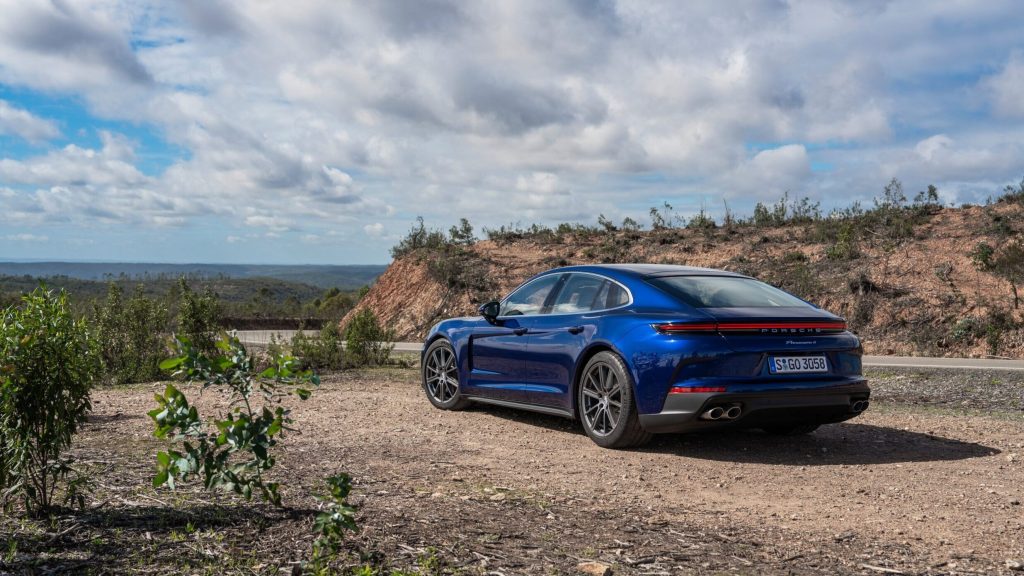
Indeed, Porsche redesigned every exterior panel for the new Panamera, apart from the door skins. The new front bumper fascia features larger air intakes, including a vent above the front number plate, and air blades are integrated into the outermost vents to improve aerodynamic efficiency. The hood is more sculpted, and the top of the front guards has been raised to give drivers a more 911-like view through the windshield.
At the rear, above the new rear bumper and rear lights, is a new hatchback lid with glass that extends out to the inner edge of the pillars rather than being enclosed in a metal frame. But perhaps the most significant styling change – most noticeable on cars with bright trim around the side windows – is the slightly more formal double apex kink in the C-pillar that replaces the Nike-like swoosh of the outgoing car.
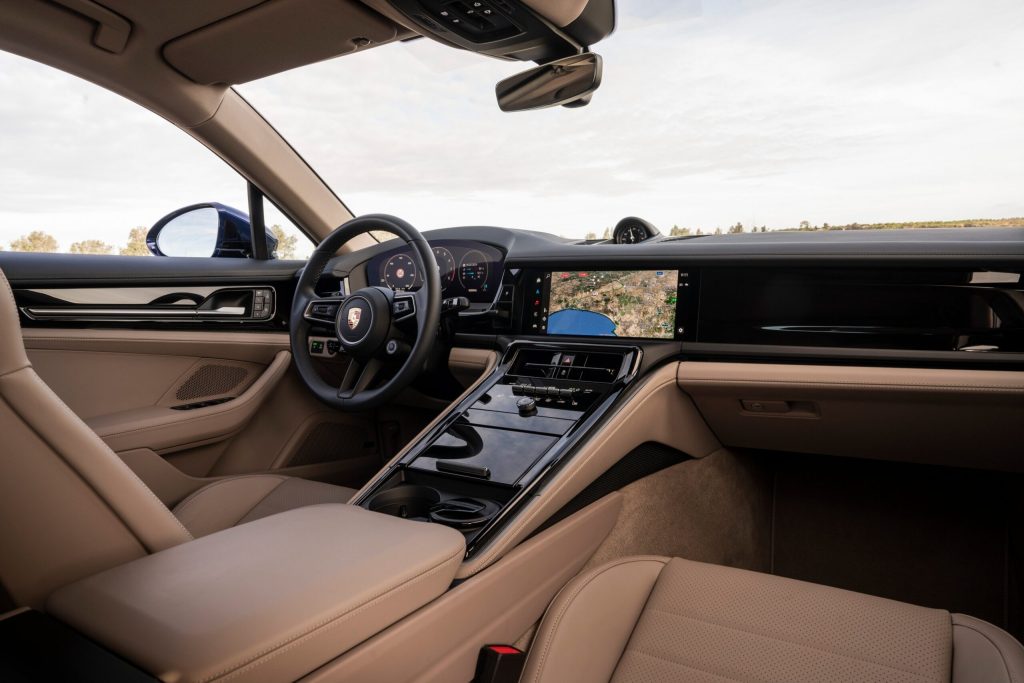
Inside, the new Panamera features the multi-screen dash layout seen in the electric-powered Taycan. The 12.6-in digital instrument panel is split into three different independently configurable sections. At the centre of the dash is a 12.3-in touch screen to handle infotainment chores. An optional 10.9-in screen for front seat passengers can stream video content even while the car is moving, albeit digitally shielded from the driver’s view to avoid distraction.
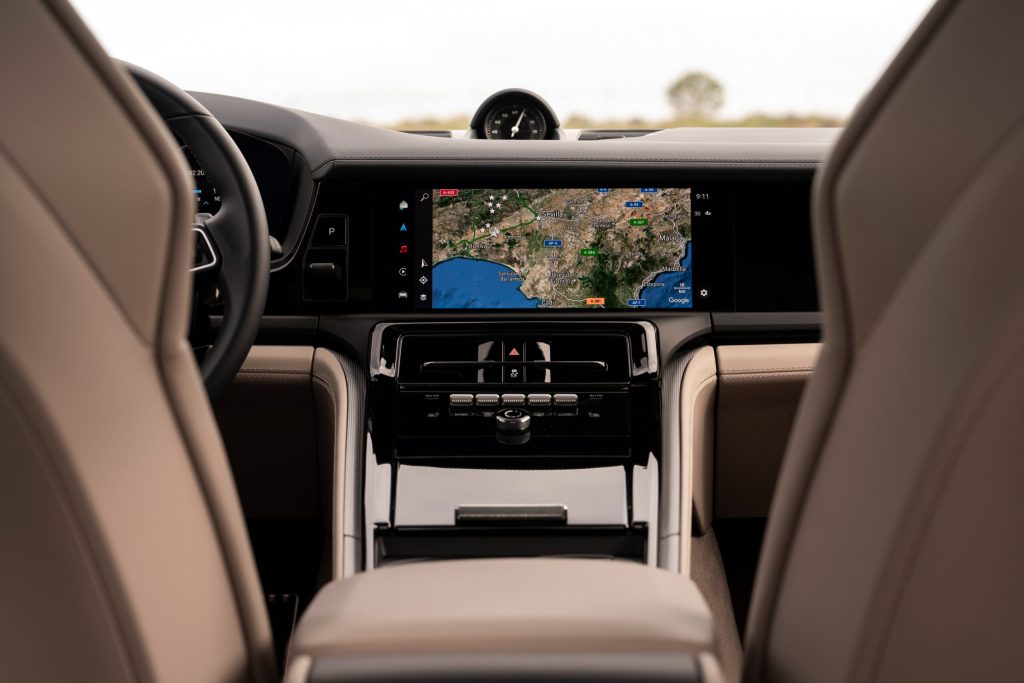
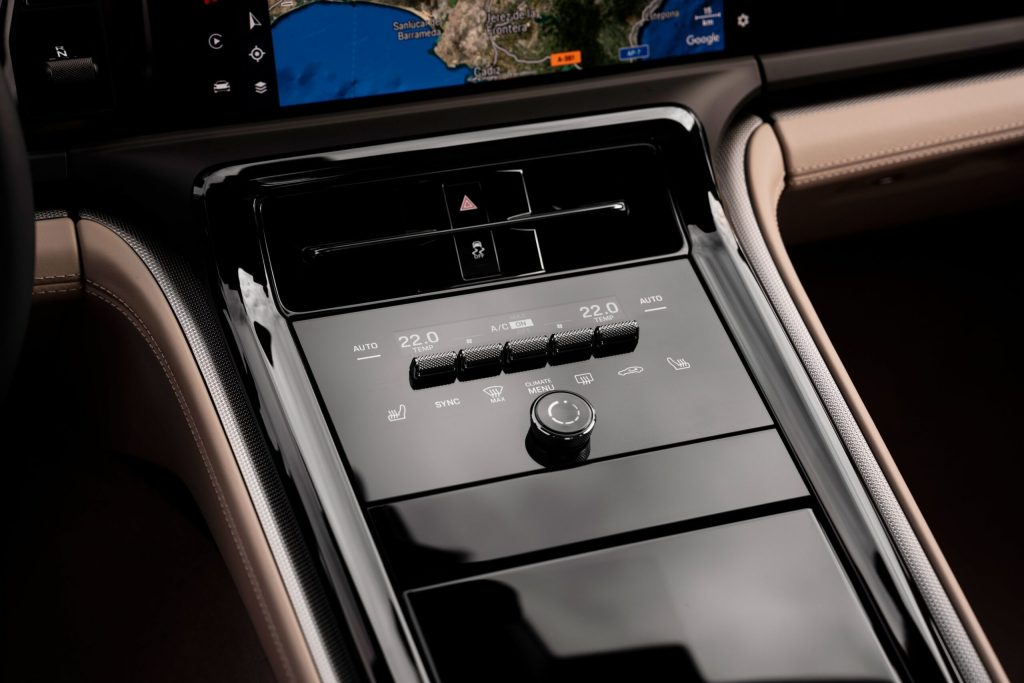
The redesigned centre console has no shifter. Instead, a small toggle-like gear selector, similar to that used in the 911, is located on the dash, next to the steering wheel. New door trims feature elements that can be configured in a mix and match of colours and materials. Ambient lighting bounces off surfaces in the doors and under the dash to produce gentle washes of colour around the cabin.
The entry-level, £79,500 rear-drive Panamera and the £82,500 all-wheel-drive Panamera 4 are powered by the same 2.9-litre turbocharged V6 used in the outgoing car, driving through an eight-speed dual-clutch transmission. However, changes to turbo boost pressure, fuel injection flow rate, and ignition timing have boosted power to 348bhp and torque to 368lb ft, increases of 22bhp and 36lb ft.
Specs: 2024 Porsche Panamera
- Price: £79,500 Panamera/£82,500 Panamera 4 (Base); others TBA
- Powertrain: 2.9-litre twin-turbo mild-hybrid V6; 2.9-litre twin-turbo V6 with co-axial PSM electric motor; 4.0-litre twin-turbo V8 with co-axial electric motor; 8-speed dual-clutch transmission
- Horsepower/Torque: 348bhp, 368lb ft (Panamera and Panamera 4); 464bhp, 479lb ft (Panamera 4 E-Hybrid); 536bhp, 553lb ft (Panamera 4S E-Hybrid); 670bhp, 686lb ft (Panamera Turbo E-Hybrid)
- Layout: Rear- and all-wheel drive, four-door, five-passenger sedan
- Kerb Weight: 4295–5202 lb
- Fuel economy: N/A
- 0–60mph: 5.0sec (Panamera); 4.7sec (Panamera 4); 4.1sec (Panamera 4 E-Hybrid); 3.5sec (Panamera 4S E-Hybrid); 3.0sec (Panamera Turbo E-Hybrid)
- Competitors: Mercedes-Benz S-Class; BMW 7 Series; Audi A8
Porsche claims the rear-drive Panamera will sprint from 0 to 60 mph in 5.0 seconds and reach a top speed of 169mph. All-wheel-drive traction gets the Panamera 4 to 60mph three-tenths of a second quicker, but drivetrain losses knock the top speed back to 168mph. Even on an autobahn, few would notice.
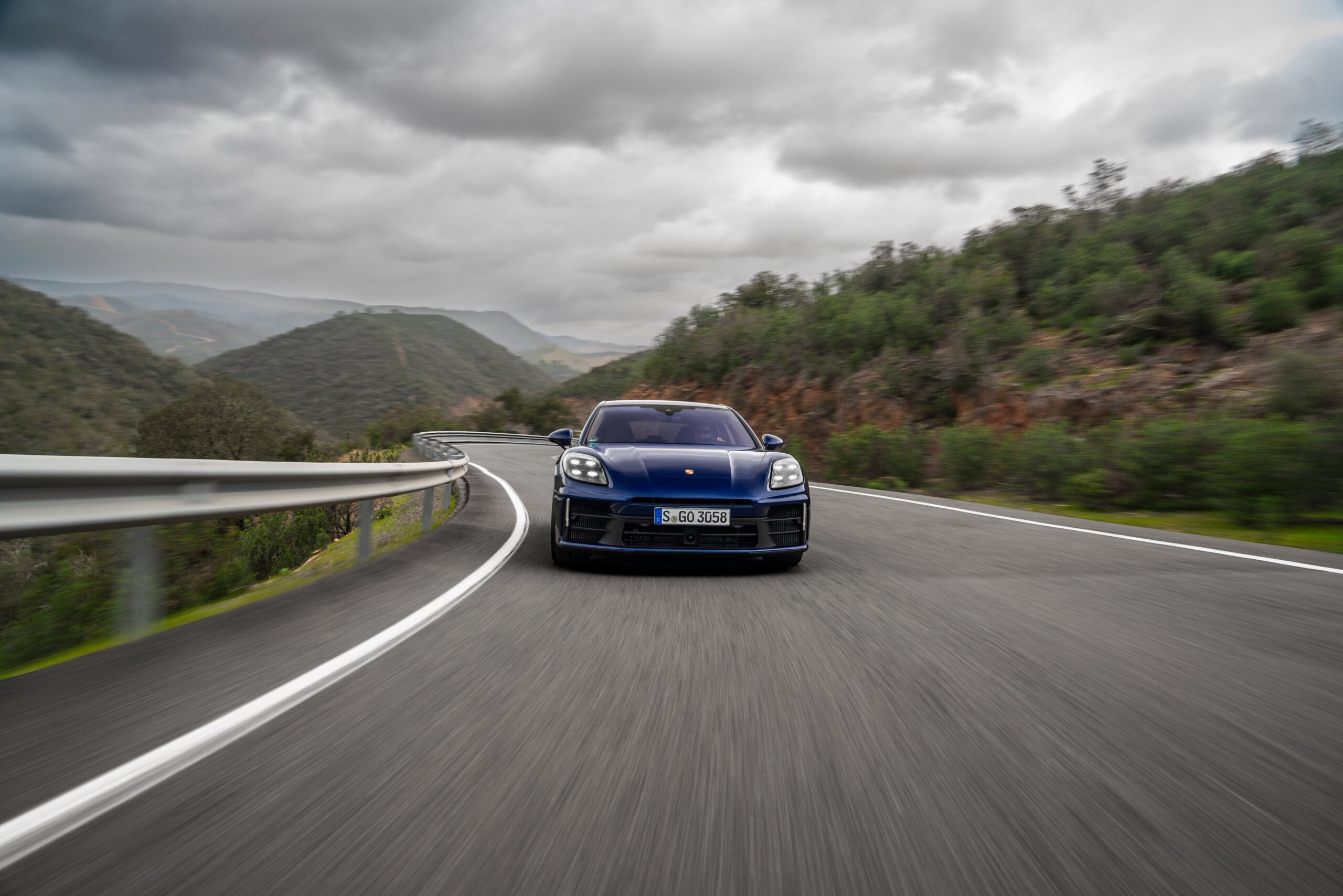
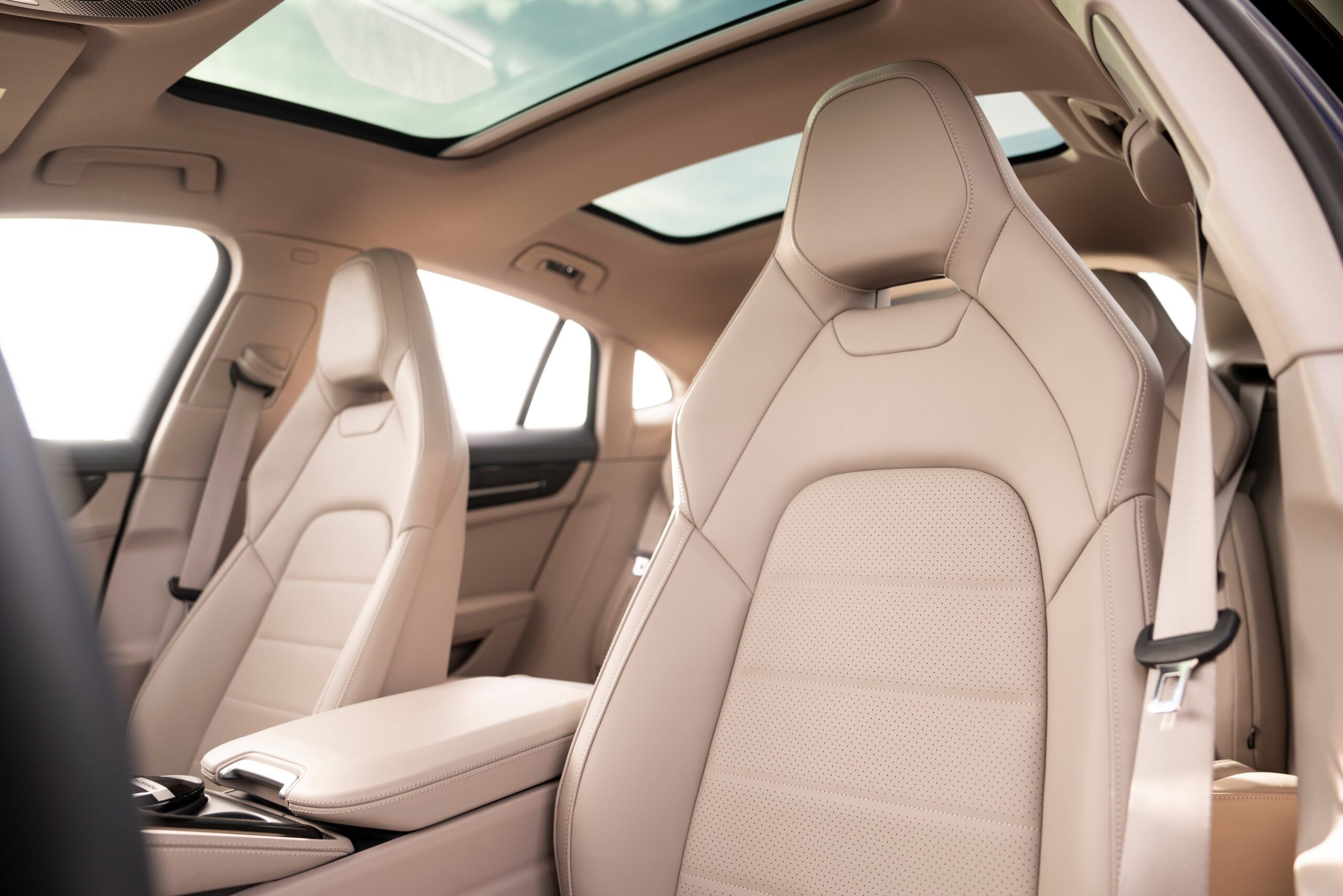
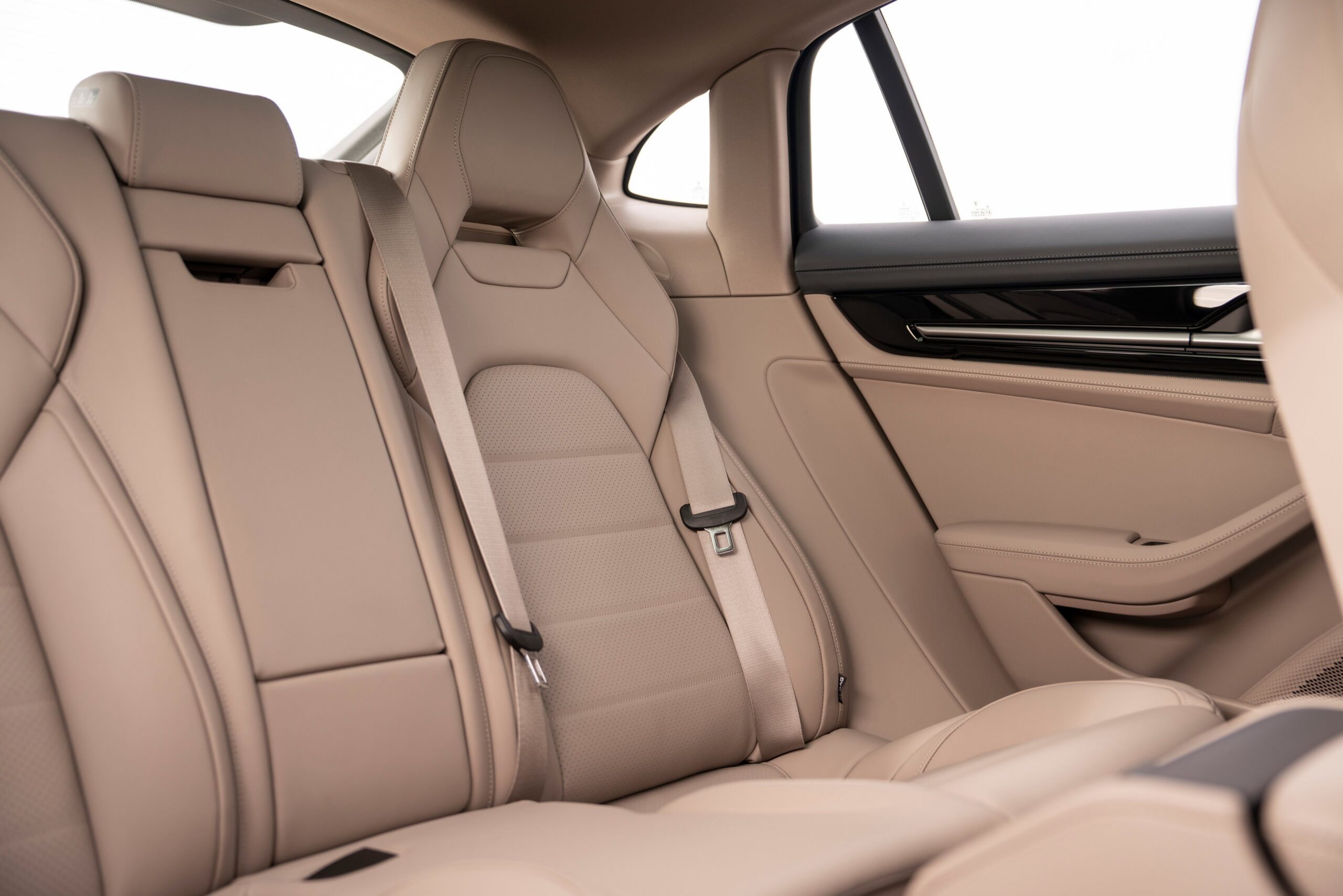
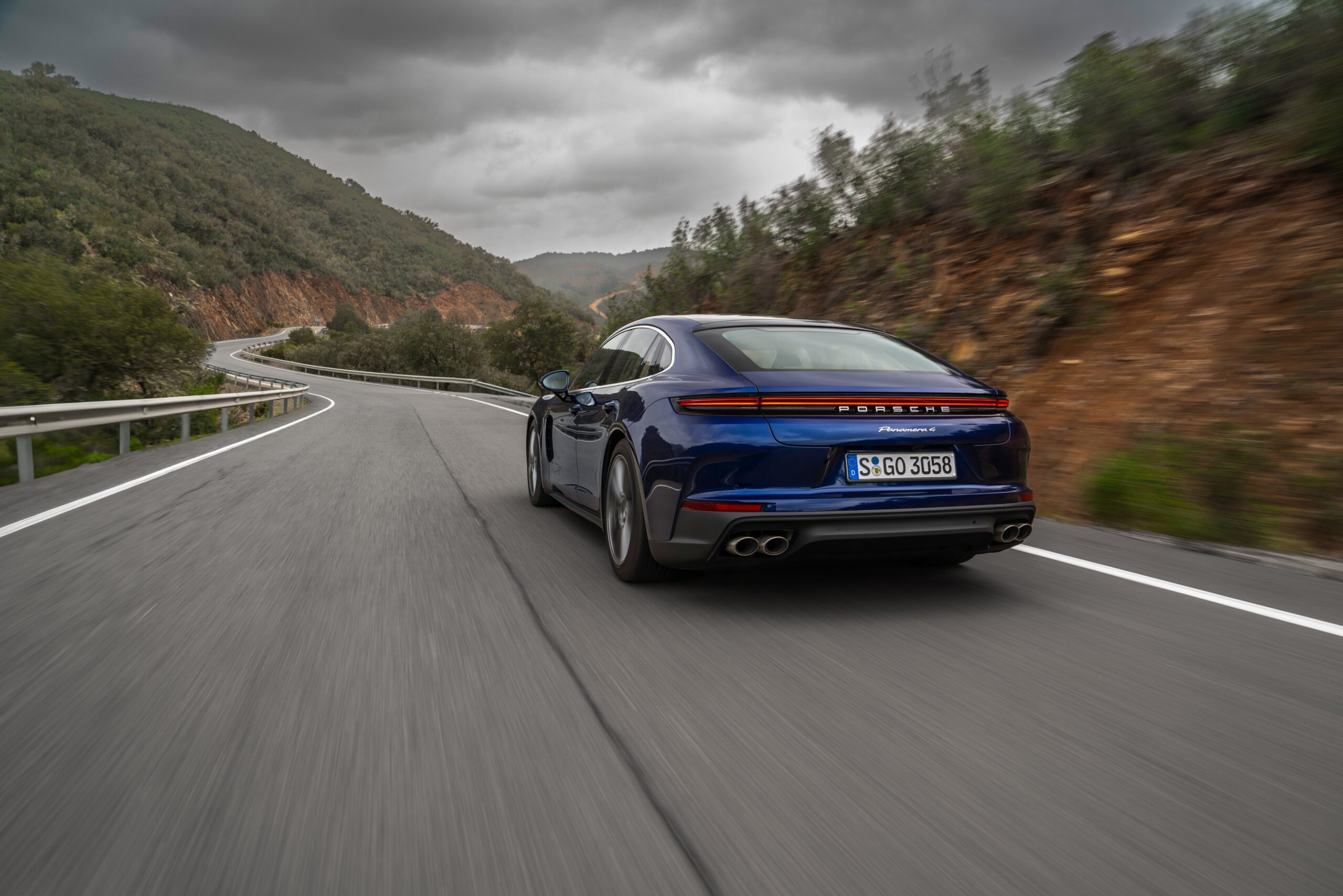
Three more Panamera variants are set to join the US lineup in the next few months, all of them plug-in hybrids. The Panamera 4 E-Hybrid and Panamera 4S E-Hybrid combine the V6 engine with a new, co-axially mounted, 187hbp, 332lb ft e-motor located within the housing of the redesigned eight-speed dual-clutch transmission.
In the Panamera 4 E-Hybrid, the V6’s output has been dialled back to 300bhp and 309lb ft, reductions of 14 and 16 per cent, respectively, compared with its tune in the base car, but the heft of the e-motor still delivers a system output of 464bhp and 479lb ft. That’s enough to get the car to 60 mph six-tenths of a second quicker than the non-hybrid Panamera 4 and on to a top speed of 174mph.
With all 348 horses and 368lb ft pumping from the V6 under its hood, the Panamera 4S E-Hybrid packs a total system output punch of 536bhp and 553lb ft. It will dispatch the 0-to-60-mph sprint in about 3.5 seconds, says Porsche, and reach a top speed of 180mph.
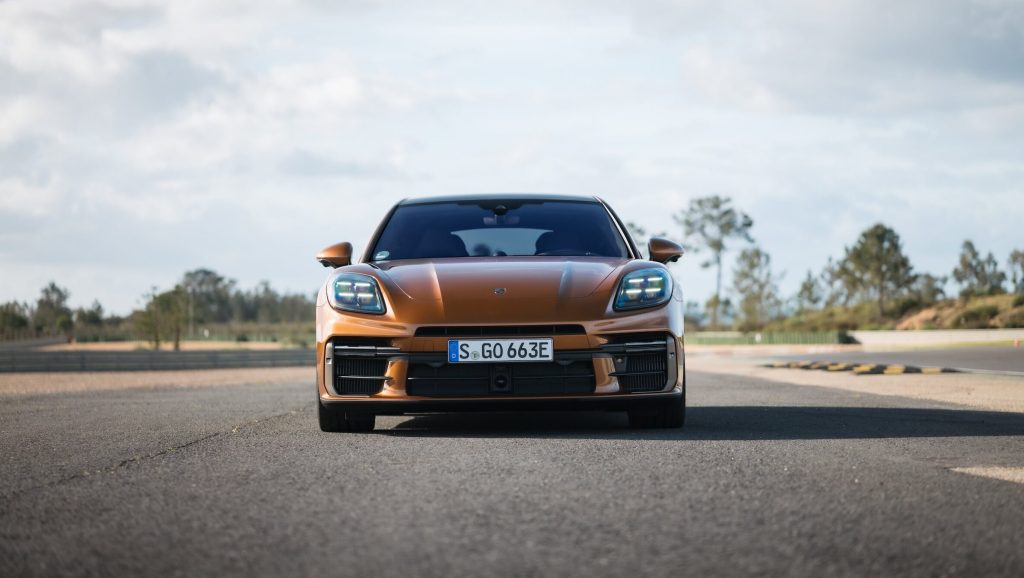
Top of the range – for now – is the Panamera Turbo E-Hybrid, whose plug-in hybrid powertrain is anchored by Porsche’s versatile 4.0-litre twin-turbo V8 and produces a total system output of 670bhp and a thumping 686lb ft of torque. That’s just 20bhp fewer than the outgoing Turbo S E-Hybrid, but with 45lb ft more torque it’s enough to make the Turbo E-Hybrid just as quick, with a claimed 0-to-60mph acceleration time of 3.0 seconds and a top speed of 196mph.
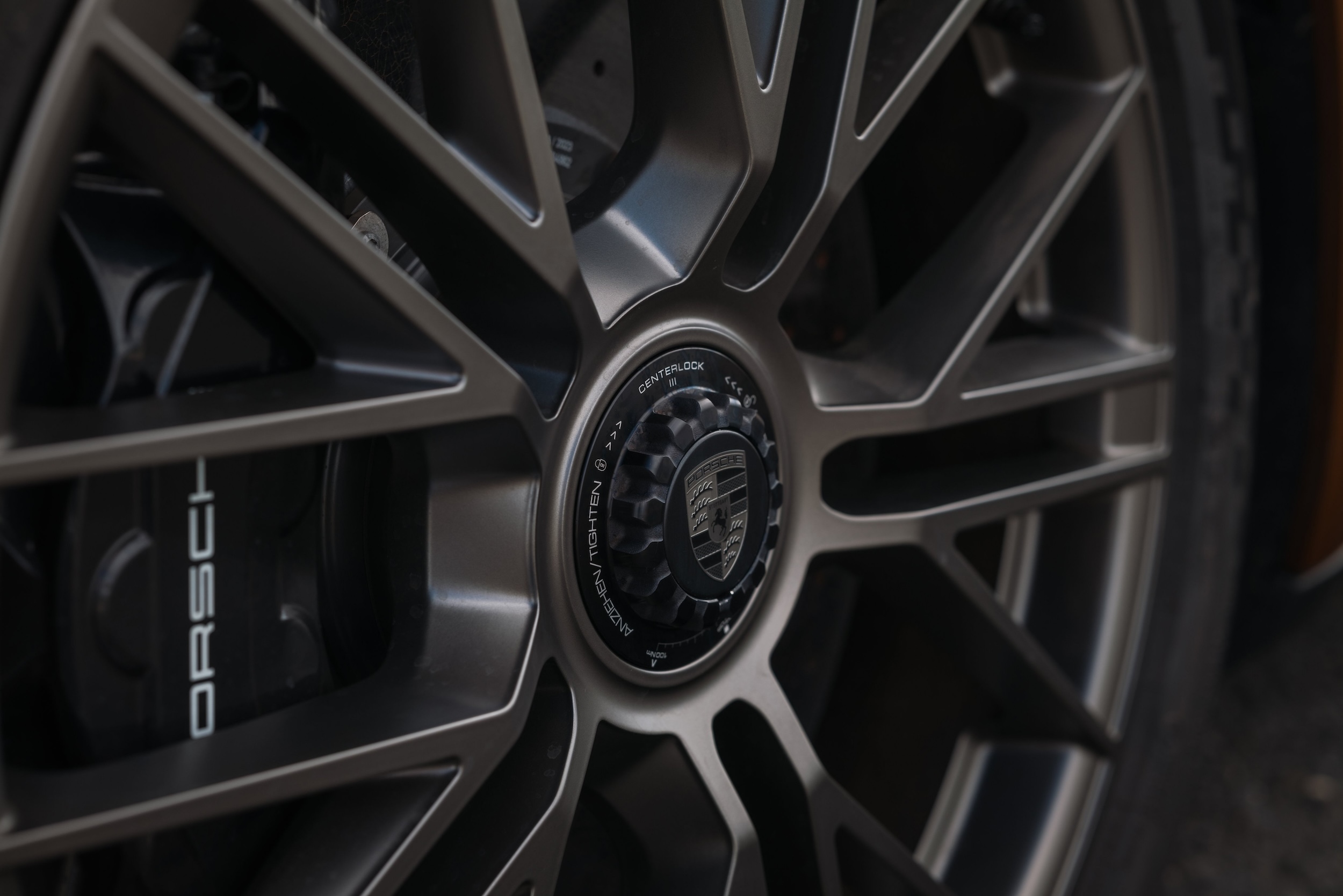
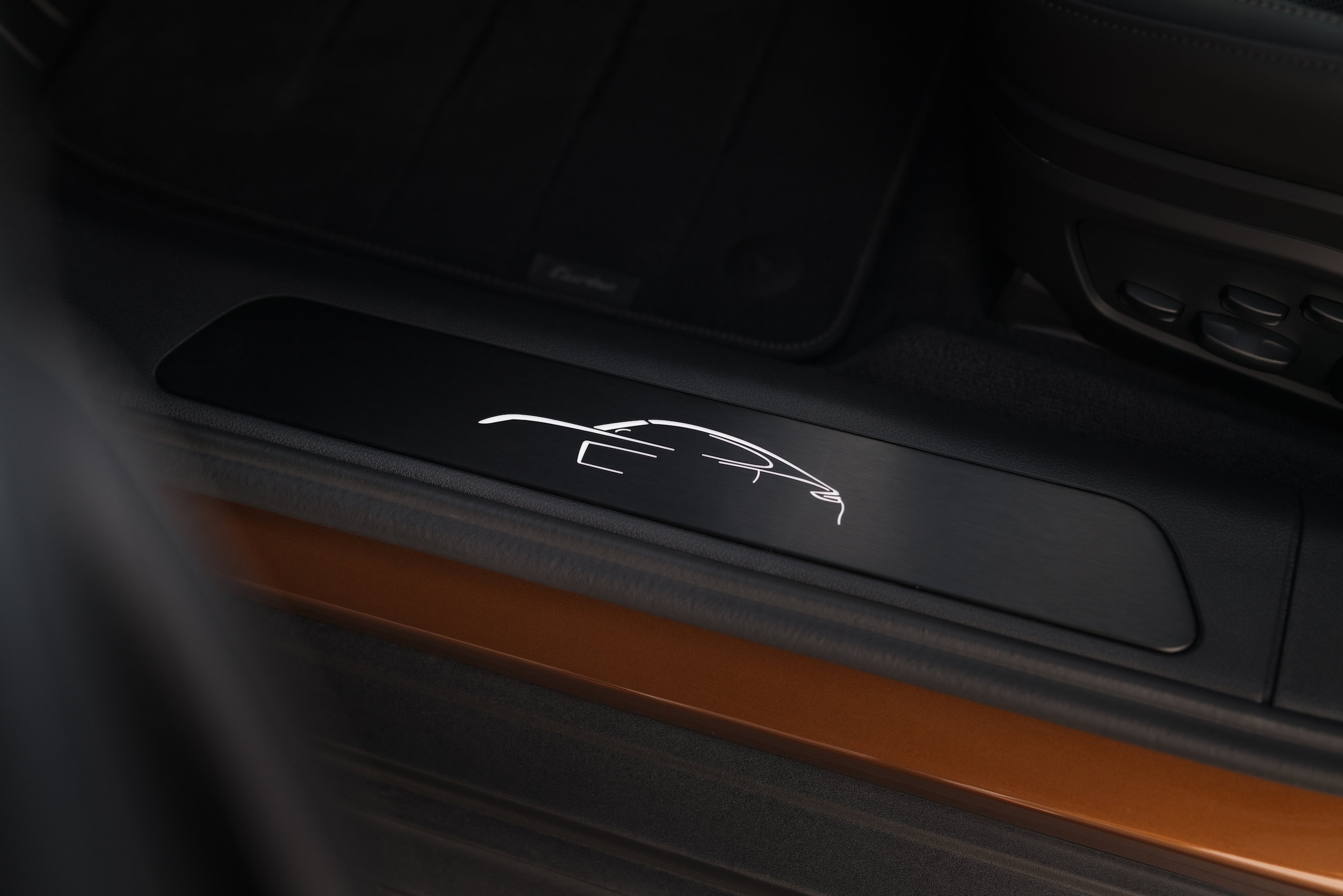
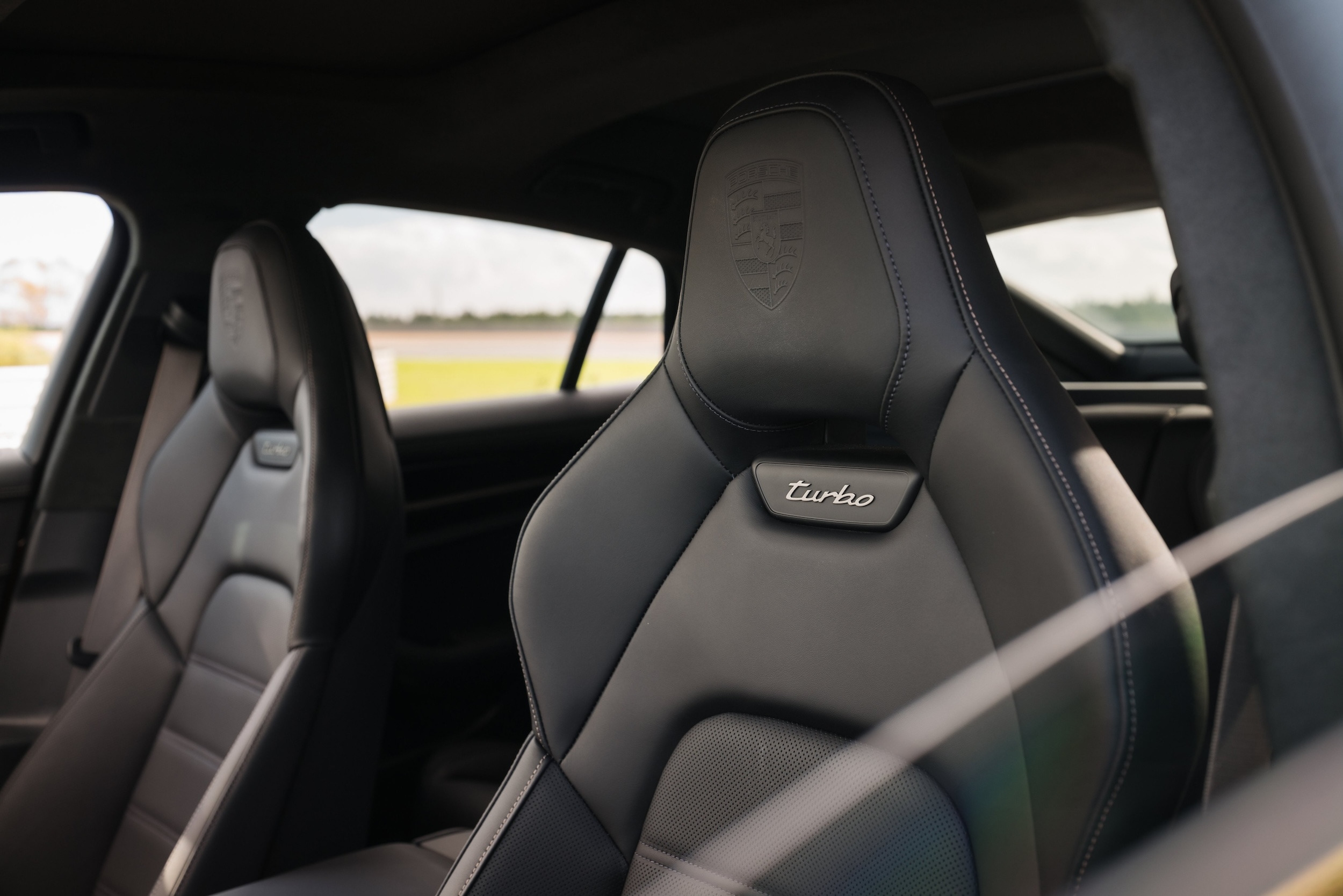
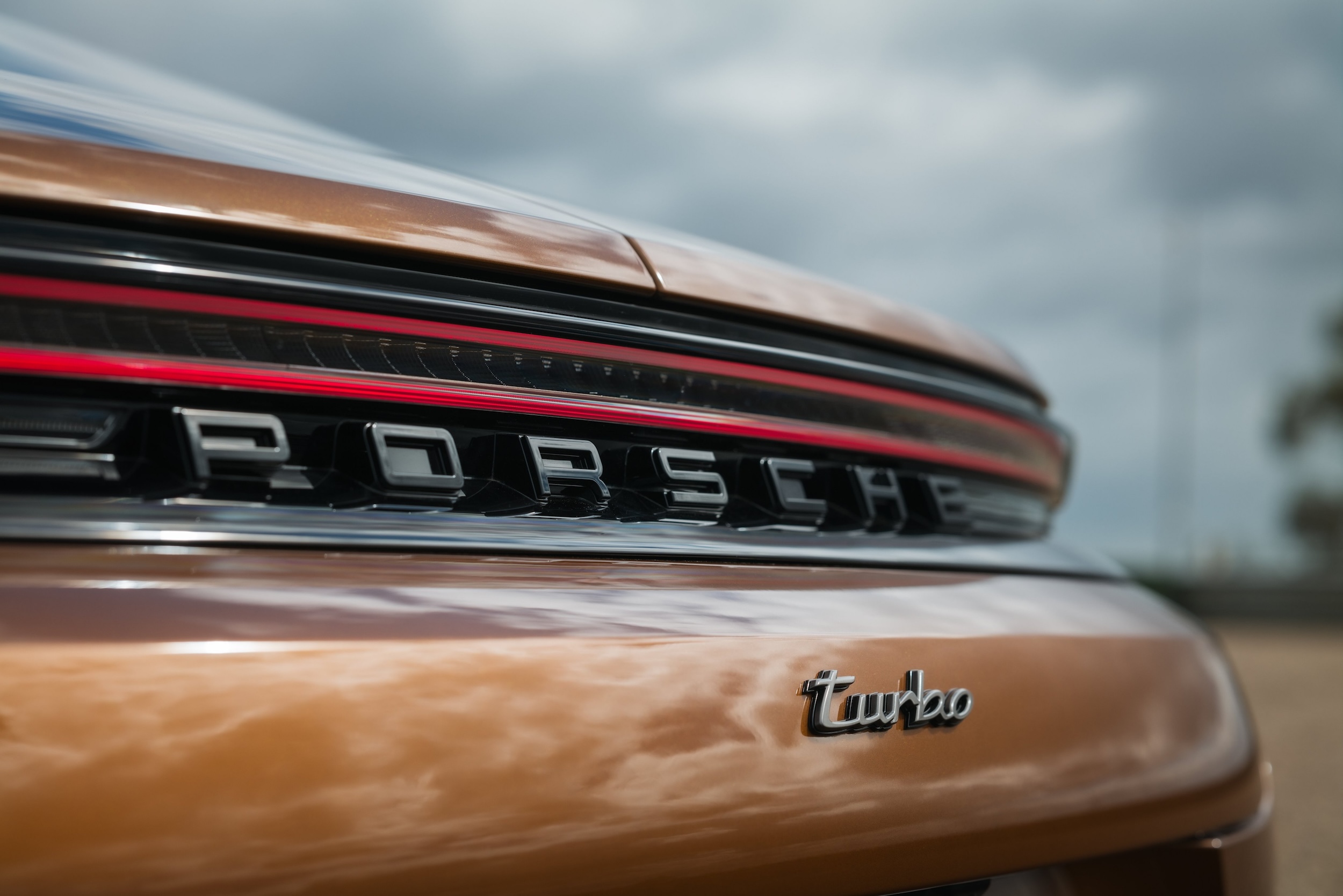
A new Panamera Turbo S E-Hybrid is coming, confirms Thomas Friemuth. And though he won’t talk numbers, it’s logical to assume it will have at least 700bhp and probably 700lb ft of torque.
Key to the new PHEV Panameras is the eight-speed PDK transmission, which has been redesigned not just to accommodate the e-motor, but also to handle much more torque than the old unit. The compact e-motor’s design is unusual, the inner spinning inside a fixed outer element, which Friemuth says reduces inertia by half, improving response.
The design also allows for the e-motor to be oil-cooled using the transmission oil, which reduces weight by 11 pounds and enables it to produce a higher continuous output. Additionally, the internal combustion engine can be decoupled from e-motor and transmission, enabling the new Panamera to coast with the engine shut down when you lift off the accelerator pedal.
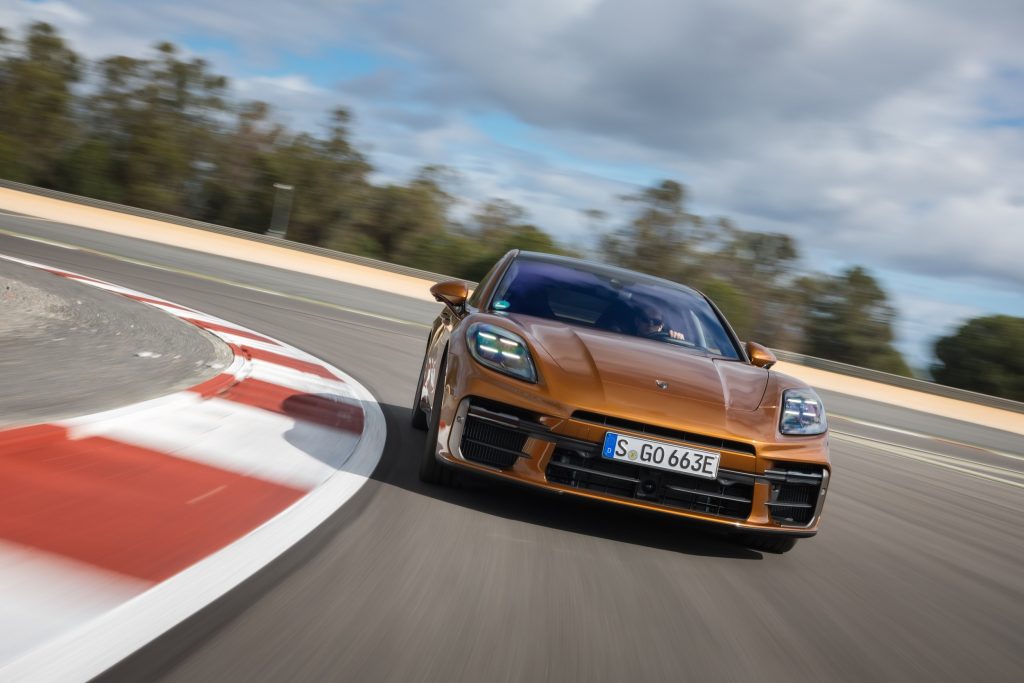
Powering the e-motor is a 25.9kWh battery that has 45 per cent more capacity than the battery in the outgoing PHEV Panameras and has almost doubled the pure EV driving range to a claimed 56 miles. Why 56 miles, rather than the 62-mile range that now seems to be the benchmark for German premium PHEVs? Friemuth says Porsche’s research showed that, on average, most PHEV owners rarely travelled more than 50 miles in a day. Opting for a 56-mile range meant the size of the battery could be made slightly smaller, saving weight.
That said, the Panamera Turbo E-Hybrid is no feather, tipping the scales at 5202 pounds – a hefty 907 pounds more than the V6-powered rear-drive Panamera.
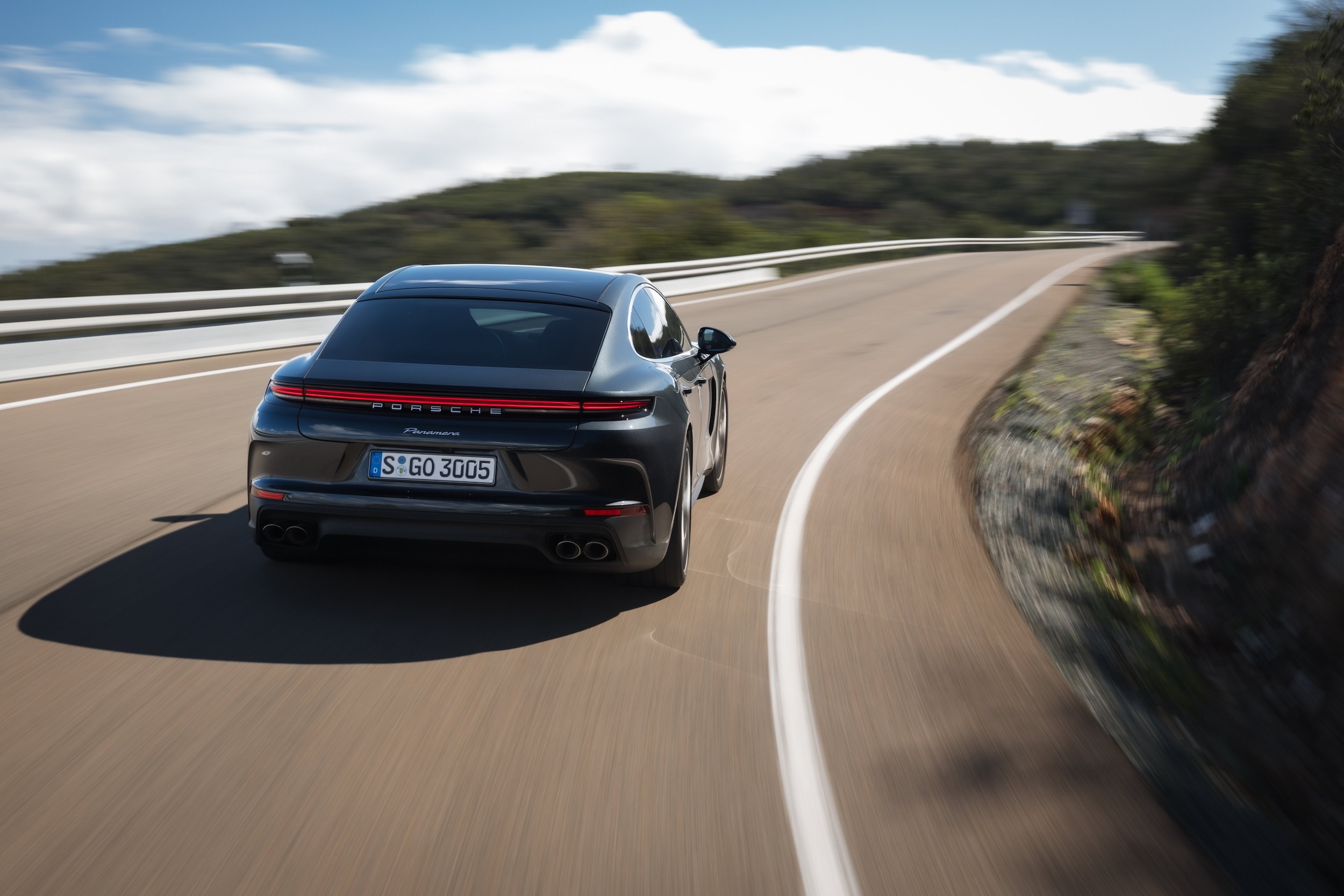
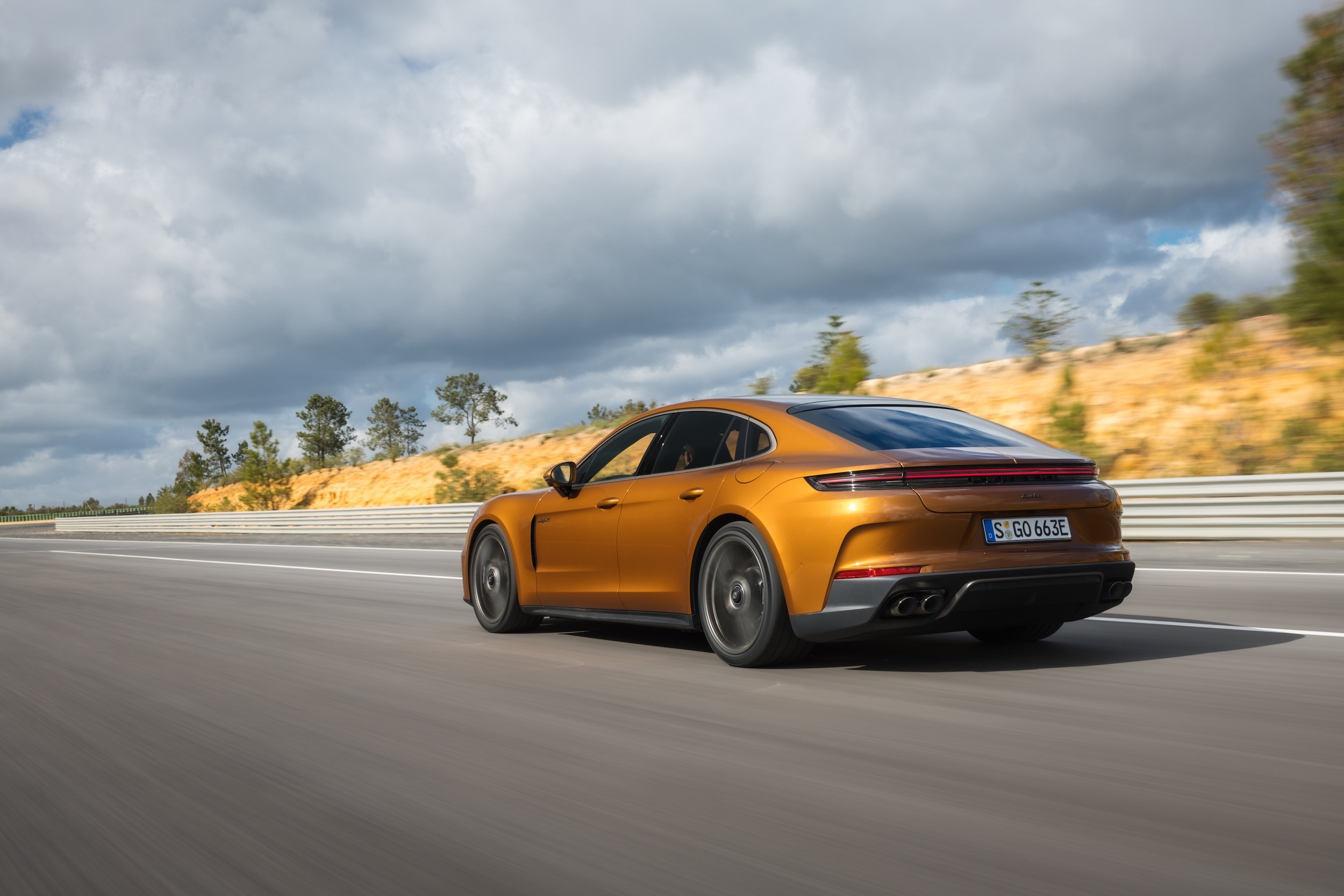
Air suspension is standard on the new Panamera, but the outgoing car’s three-chamber air springs have been replaced with simpler, lighter two-chamber units. The key enabling technology here is supplier ZF’s two-valve damper, which, according to vertical dynamics engineer Jochen Liebold, allows independent tuning of compression and rebound damping. In essence, the tech makes three-chamber springs redundant. The dampers are also central to the new Panamera’s headline technology – Porsche Active Ride (PAR).
In simple terms, PAR uses four fast, ultra-precise pumps to actively control the force at each wheel in both compression and rebound by pumping fluid through the dampers to push or pull the wheel. Pump control units – one for each axle – can detect what is happening at each wheel every millisecond, and the pumps can independently vary the compression and rebound damping force acting on each wheel by plus or minus 10,000 newtons in 30 milliseconds.
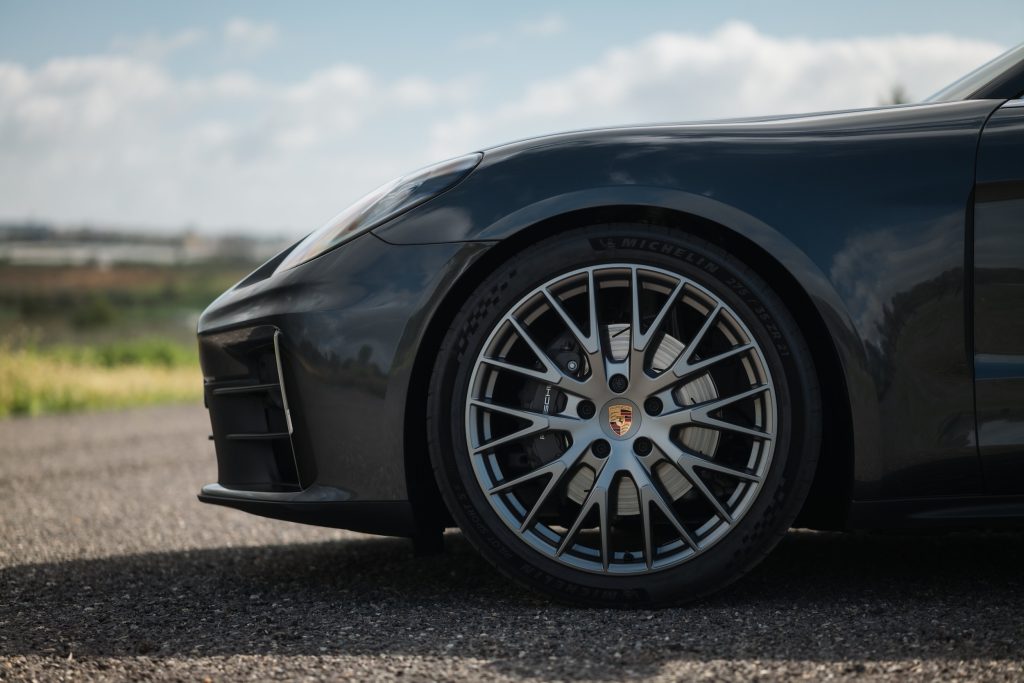
PAR allows Porsche dynamics engineers to create forces that control the acceleration, velocity, and travel of each wheel – and the motion of the body in relation to the wheel – in nearly real-time.
Electronic complexity (the new Panamera has a four-core CPU, and one core alone is needed to control PAR) has enabled mechanical simplicity. There are no physical anti-roll bars, and the car rides on single-chamber air springs. Overall, the PAR system weighs the same as the 48V anti-roll setup used in the outgoing Panamera. It will only be available as an option on PHEV versions of the new Panamera because it needs the car’s 400V electrical architecture to make it work.
And how does it work? In a word, brilliantly.
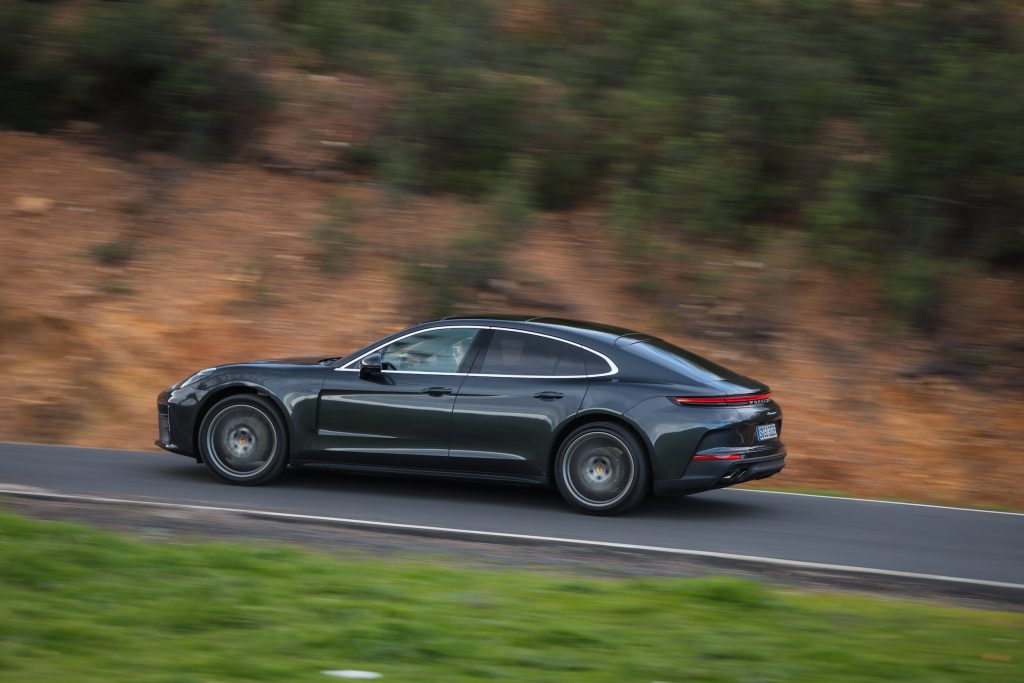
In addition to the Panamera and Panamera 4 models we sampled in Spain, we drove a PAR-equipped Turbo E-Hybrid, which comes standard with rear-wheel steering and Porsche’s Torque Vectoring Plus, on the track and on nearby roads. While the 21-inch wheels shod with aggressively sporty Michelin Pilot Sport S5 tires (275/35 up front and 325/30 at the rear) mean there’s some noise and impact harshness (which is heard more than felt), PAR made the Panamera otherwise feel as calm and composed as a Mercedes-Benz S-Class without compromising its sporty dynamics.
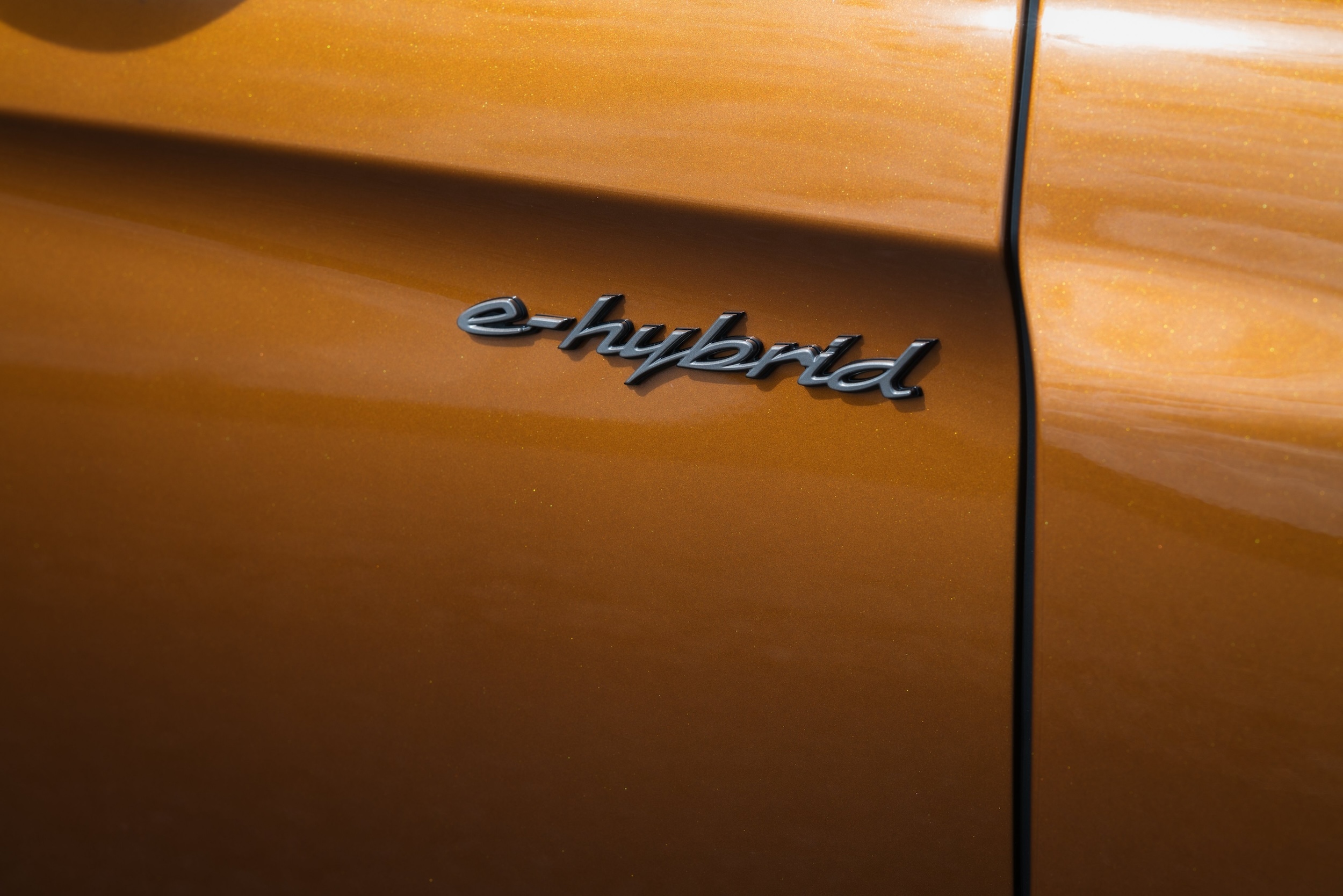
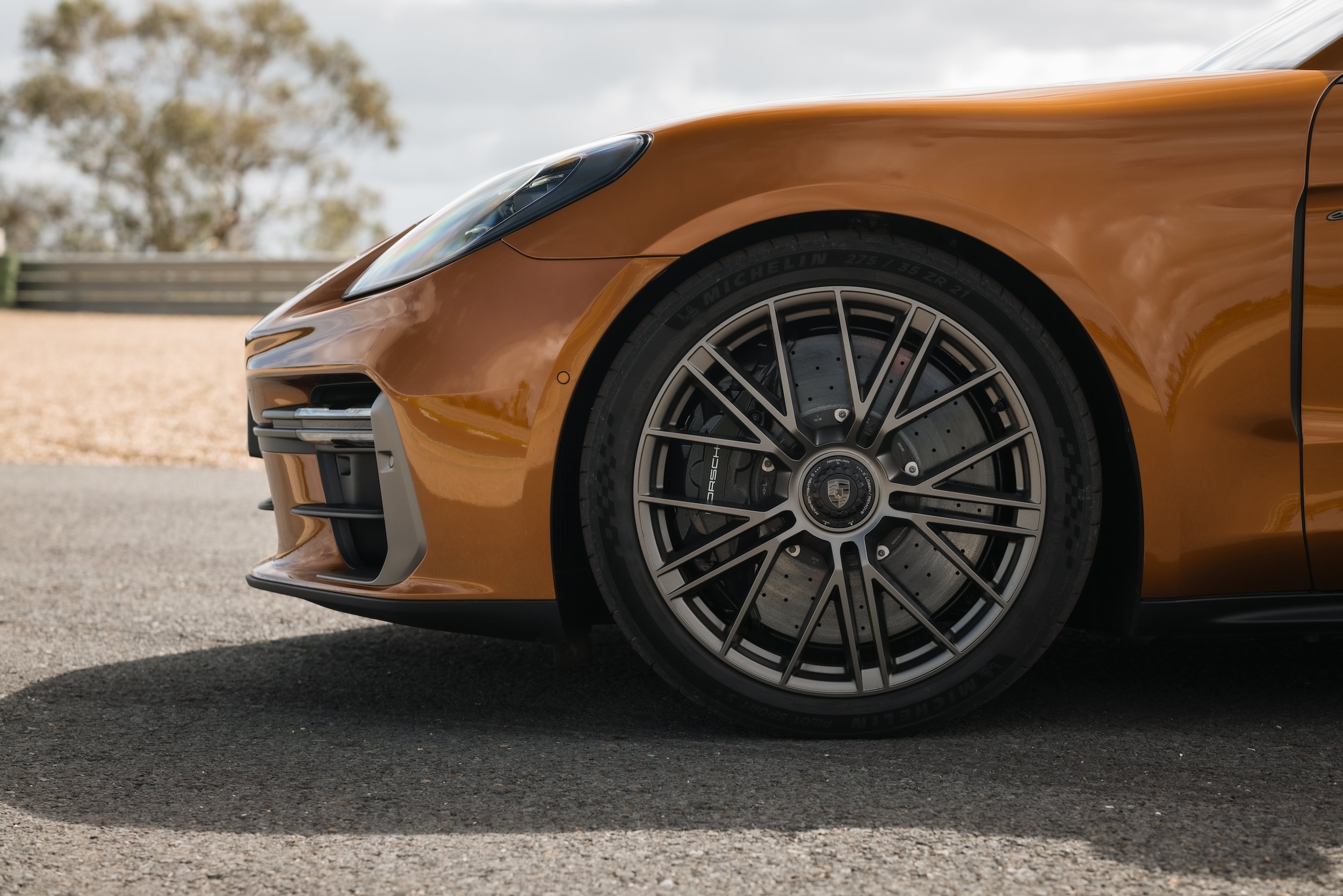
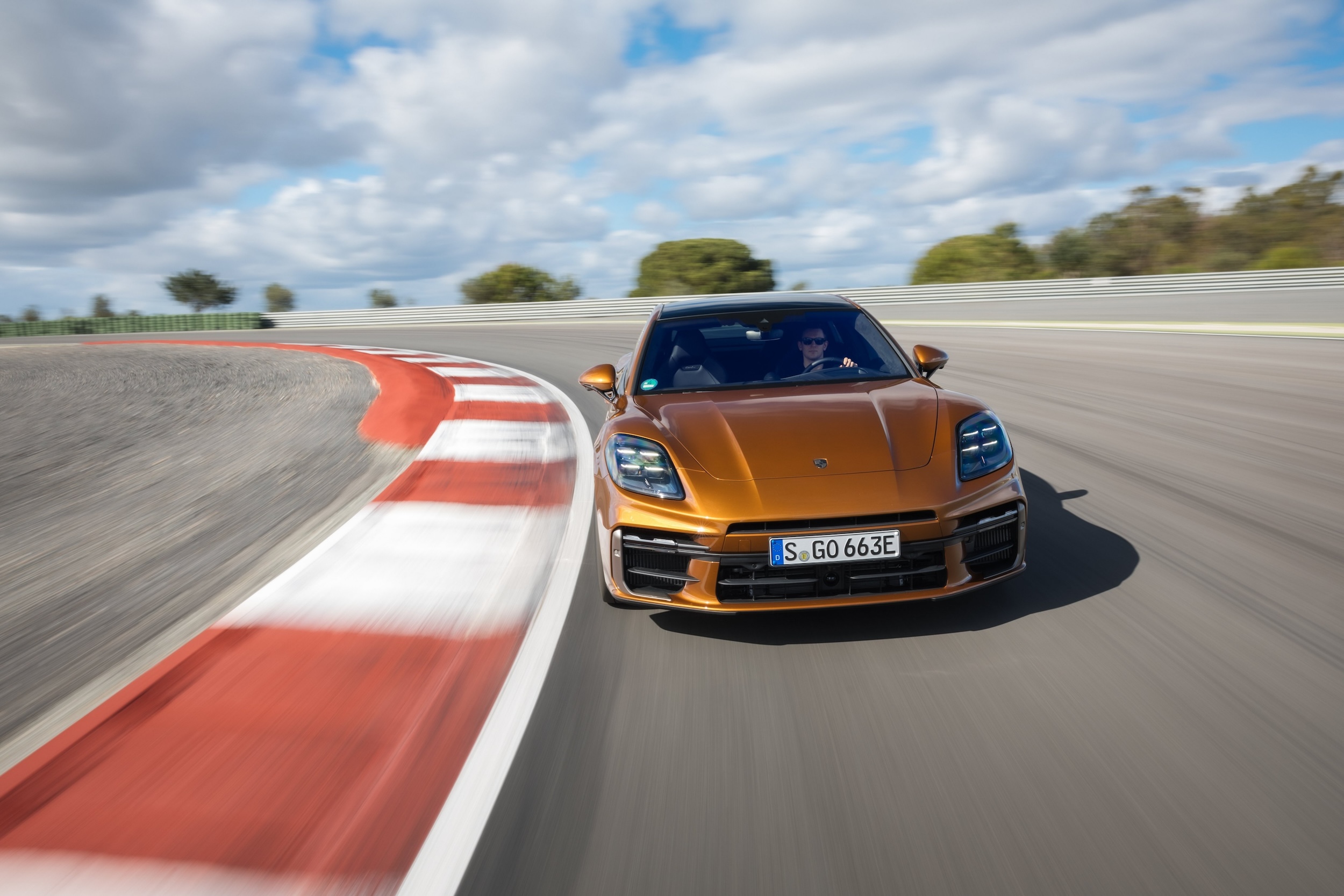
The primary ride is outstanding, the body barely moving as the suspension shrugs off humps and heaves that would leave other cars crashing down on their bump stops. Body roll through corners, along with dive and squat under braking and acceleration, are virtually eliminated. The system also actively changes the ride height, lowering the car mid-corner to lower its centre of gravity.
Despite the furious flow of electrons making all this happen, the feedback through the steering and through the seat of your pants is concise and granular. (Jochen Liebold says Porsche Active Ride could have been tuned to eliminate all body motions, but test drivers complained of a lack of feel.) Even when the car is stationary PAR is alert and ready to react, instantly raising the car 5.6cm when you open the door to make entry and egress easier.
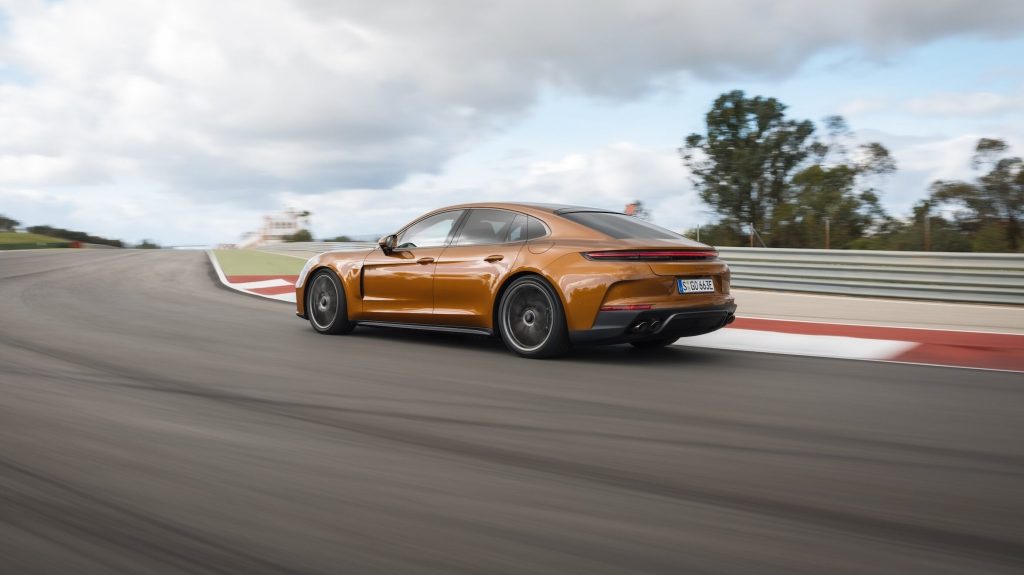
The Turbo E-Hybrid’s default drive mode, Hybrid Auto, allows drivers of PAR-equipped models to select additional functions that will tilt the car into corners or raise the nose under braking and the tail under acceleration. These counter-intuitive motions are designed to reduce the sensation of g-loads for passengers, but experienced drivers will prefer the greater connection with the road surface afforded by the standard PAR settings.
Porsche Active Ride won’t be cheap; in Germany, it’s the equivalent of an £7000 option. But given that amounts to barely a four per cent bump over the car’s base price, and about what Porsche charges for the PCCB carbon-ceramic brake package that you’ll only ever (doubtfully) fully employ on a track day, it’s worth every penny. You’ll feel the money well spent every time you get behind the wheel.
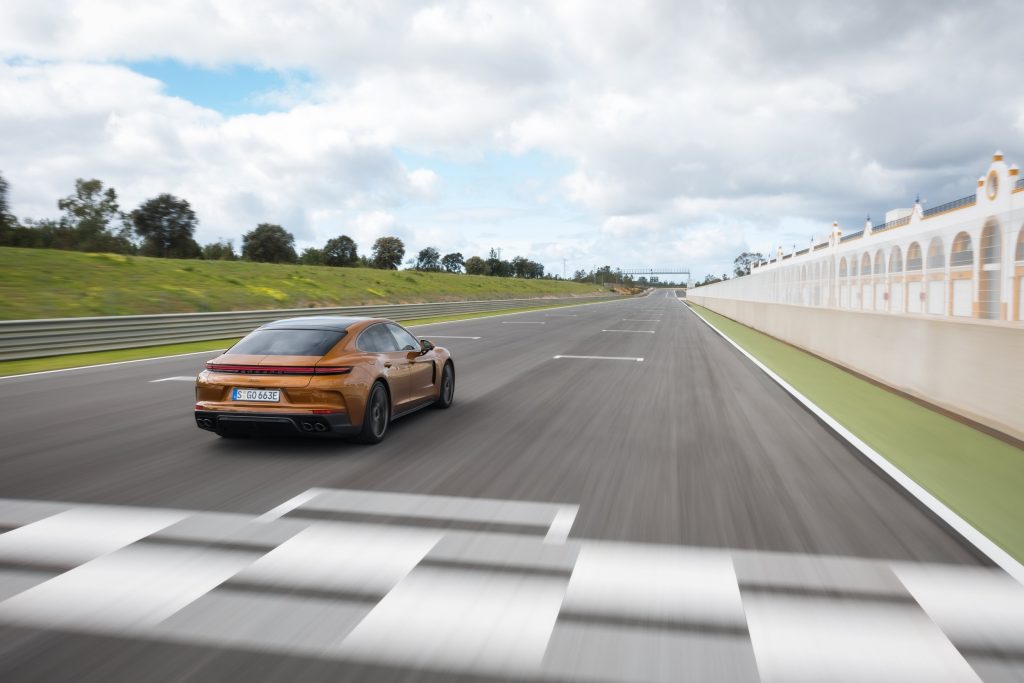
The Panamera and Panamera 4 models confirmed the myriad detail engineering and design changes have indeed added more speed, more sparkle, and more refinement to the basic Panamera package. The upgraded 2.9-litre V6 delivers noticeably more punch, particularly in the mid-range, and snarls smoothly to its 6750rpm redline. There’s a precision in the steering and in the braking that’s impressive for a car just over 5 metres long and 1.94 meters wide, rolling on a 2.95-metre wheelbase, and the revised suspension delivers a calmer primary ride, and better wheel control.
Consider that 2024 Porsche Panamera exists at the same company in which an army of talented engineers in Weissach are spending millions of man-hours trying to make the tall, clunky, hot-selling Cayenne SUV drive as well as it does. The truth is, if you want a roomy, versatile four-door Porsche that, well, drives like a Porsche, don’t buy a Cayenne. Buy a Panamera.
2024 Porsche Panamera
Highs: Complex PHEV powertrain and Porsche Active Ride are not just Porsche engineers showing off. The benefits are the real deal.
Lows: Exterior redesign might be a little too subtle for those who want to show off at the country club.
Takeaway: More performance, more refinement, more panache – together it makes this 2024 Panamera feel a lot more than “refreshed.”











For God’s sake, bring a non hybrid V8 to the lineup!! Seems Porsche went to great lengths to make the V8 emissions compliant for the next decade in the Cayenne S, and would use it in more than one platform. I would hope that the Panamera range mimics the Cayenne and we get a V8 4s model.